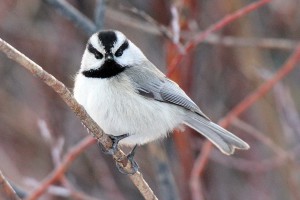- Make the diameter of the entrance hole 1-1/8 inches. This prevents larger birds, like House Sparrows, from getting inside & displacing your chickadees.
- Place your nest box in or at the very edge of the woods. Chickadees won’t use it if it’s in a field.
- Hang the bird house securely to a tree (don’t let it swing freely) between 5 & 15 feet high.
You can either build a nest box yourself or buy a pre-made chickadee house online.
Try identifying Black-capped Chickadees by their sounds!
These birds are extremely vocal, & you should have no problem hearing one. And luckily, their vocalizations are unique & relatively easy to identify.
Listen for a song that is a simple 2 or 3 note whistle, which sounds like it’s saying “fee-bee” or “hey sweetie.”
Black-capped Chickadees also make a distinctive “chickadee-dee-dee” call. And yes, it actually sounds like they are saying their name! Interestingly, they add more “dee” notes onto the end of the call when alarmed.
Lastly, these birds have incredible memories! They hide seeds & other foods in their territory to eat later, which are all hidden separately. Somehow, their brains can remember THOUSANDS of different hiding places!
#2. Carolina Chickadee
Carolina Chickadees are small birds with a distinctive black cap & bib, dull white cheeks, a gray back, & white underparts. Both males & females look the same.
Look for them in a wide variety of habitats across the southeast. You should be able to spot Carolina Chickadees in the United States in deciduous & mixed woodlands & swampy areas. They also adapt well to humans & are extremely common in parks & suburban & urban backyards!
Like most chickadees, they are intensely curious & intelligent. Try attracting them to your backyard by offering a mixture of sunflower seeds, peanuts, & suet. Because of their small size & acrobatic abilities, they can use almost every type of bird feeder.
What sounds do Carolina Chickadees make?
The most common song you will hear them making is a 4-note whistle, which sounds like “fee-bee-fee-bay.” Typically, the first & third notes are higher in pitch than the second & fourth.
They also have a call that sounds like they are saying their name “chick-a-dee-dee.”
How can you tell Carolina & Black-capped Chickadees apart?
If you hadn’t noticed, these 2 birds look almost identical! Trying to tell them apart takes a lot of practice, but it can be done. Here are the best ways to identify each bird:
Location:
For the most part, these 2 birds don’t live in the same areas. Carolina Chickadees are birds of the southeast, while Black-capped Chickadees live more north. But, there is some range overlap between the 2 species, in which case you will need to rely upon another indicator.
Appearance:
At first glance, these 2 birds appear identical. But believe it or not, there are some small differences in the way they look. A Carolina Chickadee’s wings are darker & grayer. Black-capped Chickadees have white on the wing edges.
Song:
Vocalizations aren’t a ton of help where the ranges meet since each species can learn the other’s songs! The only clue you may have is that Carolina Chickadees tend to say “chick-a-dee-dee-dee” faster than Black-capped Chickadees. With a lot of practice, you may be able to tell the difference!
#3. Mountain Chickadee
As the name suggests, if you want to find Mountain Chickadees in the United States, you will need to head to the mountains! Look for small birds with black heads & a distinctive white eyebrow, which makes them fairly easy to identify.
Like other chickadee species, these birds are agile & curious. They are most often seen flitting from tree to tree in coniferous forests, searching for insects, spiders, seeds, & nuts.
Do you have a house in the mountains?
If so, you should easily be able to attract Mountain Chickadees! Try setting up a feeding station filled with sunflower seeds, peanuts, & suet.
Listen for them singing a 3-4 note descending whistle “fee-bee-bay” or “fee-bee-fee-bee.” Some people think it sounds like they are saying “cheeseburger!”
But the most common call you will hear is “chick-a-dee-dee-dee,” which sounds very similar to a Black-capped Chickadee, even though these species tend to pay little attention to each other.
#4. Boreal Chickadee
The only chickadee in the United States with a brown cap! These birds are incredibly tough, as they live in coniferous forests in the far north all year round.
Boreal Chickadees aren’t as numerous or vocal as other chickadee species, which means it can take a bit more patience & time to locate them. But they are commonly attracted to bird feeders, which may be your best shot at seeing one since they adapt well to the presence of people!
To survive the cold & brutal northern winters, Boreal Chickadees have to hide & store A LOT of food. What’s amazing is that they can remember where they hide everything! Their main foods include insect larvae & seeds.
Boreal Chickadees are surprisingly quiet, & they don’t use songs or vocalizations to signal their breeding territory, which can make them hard to find in the forest. If you do hear one, it will be a raspy “tschick-a-dee-dee” call note, which comparatively sounds harsher than a Black-capped Chickadee.
#5. Chestnut-backed Chickadee
These chickadees are truly handsome little birds. They are easily identified by their chestnut backs & sides, which match the bark of the trees they live amongst.
Look for Chestnut-backed Chickadees in the western United States in dense coniferous forests. They can also be easily attracted to bird feeders. Just make sure your backyard has plenty of shrubs & trees they can use for cover!
During winter, it’s common to find these birds flocking together with many other species. You will frequently find them traveling with nuthatches, titmice, kinglets, & even other chickadee species.
Chestnut-backed Chickadees have a unique call when it comes to chickadees. Listen for a high, scratchy “chick-a-dee” that lasts 1 – 1.5 seconds. They also sing a series of “gargle” notes, but these noises aren’t heard often.






.jpg)


No comments:
Post a Comment